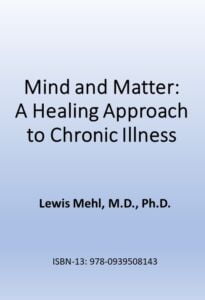 Reviewed by Winafred E. Lucas, Ph.D.
Reviewed by Winafred E. Lucas, Ph.D.
In JRT Issue 3, Spring 1987
This is a book by an established physician and psychologist that defines and grounds the concepts of holistic medicine. It delineates in a quiet and simple way approaches to healing that have the impact of an earthquake with extensive tremors. The first of these is the conviction, implied throughout the book, that healing occurs in the context of a relationship and not through techniques, which only provide the healer with a vehicle for relationship. Therapy is involved with moving into wholeness on the part of both the patient and the physician.
Mehl’s second principle of medicine is that disease is always a creative attempt to solve a problem. Only when we can understand in what way this is true can we be open to other more productive ways to solve the problem which the disease is addressing. The patient himself understands best how this is to be done, and the task of the physician is to facilitate his understanding. Pursuit of health follows the path of wholeness rather than the avoidance of disease.
Every person is a part of a larger system, such as family and community. Disease seems to concern the individual, but culture, family, and belief systems must all be examined to understand the disease. Each person is the sum of many factors and influences: environmental, nutritional, socio-cultural and family systems; childhood learning, and experiences in past lives; relationships and beliefs, to mention some of these. The healer catalyzes changes in this system so that the client has more resources to move toward wellness. Such an existential approach to health promotes multilevel well-being in a personal accountable context that contraindicates the search for specific structural causes which currently obsesses medicine.
An impactful part of the book is the discussion of body-mind interaction. In many holistic theories the interaction whereby the mind influences the body is left to inference, but Mehl’s extensive medical background and knowledge of research propose and document specific pathways. These may seem technical to the non-medical reader, but I for one appreciated that they were documented, just as in the thirties I was reassured by the new research on glandular-autonomic nervous system interaction (which would seem simplistic today). This section grounds the assumptions in the book and opens up understanding of how the techniques delineated can be effective.
Mehl explores modalities for his multidimensional approach by describing individual techniques in detail, such as visualization, applied kinesiology, various forms of non-directive hypnotherapy, and psycho physiological integration. He does not limit himself to a didactic presentation: the book contains extensive verbatim dialogues illustrating how these modalities work. Included are detailed transcripts of various relaxation techniques and methods of combining visualization with applied kinesiology. No sudden miracles of healing are described, but rather a process of careful exploration of a case of diabetes, one of asthma, and a gynecological disorder, where slowly and steadily the diseases yielded to reconstellation of the belief systems and of the phenomenological worlds of the patients.
Mehl’s personal background has contributed to the rich fabric of his conceptualization. To a childhood foundation based on Cherokee mysticism and Kentucky mountain spirituality he added doctoral degrees from Stanford in both medicine and psychology. To me, the psychologist seems to emerge most powerfully in this book, but it is a psychologist grounded by and infused with the most current medical knowledge. Surrounding everything is Mehl’s compelling respect for the healing power of relationship and for the ability of the patient to tune into his own answers about distortions in his phenomenological world. Only in this way can there be a movement out of illness and forward on the journey toward wholeness.
ISBN-13: 978-0939508143
